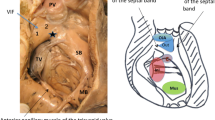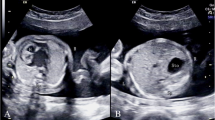Abstract
Four children are described, (three black and one white, two boys and two girls) with type A postaxial polydactyly. All four of them, in addition, had either a partial or complete atrioventricular septal defect (AVSD). None of these children had associated major malformations. Minor anomalies were observed (e.g., two patients with hypersegmentation of the sternal segments, one patient with undescended testes, one patient with hypoplastic lumbar vertebra, and one patient with a degree of craniofacial abnormality). Chromosome analysis was carried out for three of the four patients, and was normal in all of them. It is suggested that there is a specific association between type A postaxial polydactyly and the AVSD found in each of these patients. This picture does not conform to, but bears some resemblance to, the Ellis-van Creveld syndrome.
Similar content being viewed by others
References
Bauman ML, Hogan GR (1973) Laurence-Moon-Biedl syndrome: report of two unrelated children less than 3 years of age.Am J Dis Child 126:119–126
Bernstein R, Isdale J, Pinto M, Du Toit Zaaijman J, Jenkins T (1985) Short rib-polydactyly syndrome: a single or heterogenous entity? A re-evaluation prompted by four new cases.,J Med Genet 22:46–53
Bingle GJ, Niswander JD (1975) Polydactyly in the American Indian.Am J Hum Genet 27:91–99
Burn J (1987) The aetiology of congenital heart disease. In: Anderson RH, Macartnev FJ, Shinebourne EA (eds)Paediatric Cardiology, Vol 1. Churchill Livingstone, Edinburgh, pp 44, 47–63
Castilla E, Paz J, Mutchinick O, et al (1973) Polydactyly: a genetic study in South America.Am J Hum Genet 25:405–412
Da Silva ED, Janovitz D, De Albuquerque SC (1980) Ellisvan Creveld syndrome: report of 15 cases in an inbred kindred.J Med Genet 17:349–356
Jones KL (1980) 9p-Syndrome (9p monosomy). In:Smith's Recognizable Patterns of Human Malformation, 4th edn. Saunders, Philadelphia, pp 46–47
Jones KL (1988) Partial trisomy 10q syndrome. In:Smith's Recognizable Patterns of Human Malformation, 4th ed. Saunders, Philadelphia, pp 50–51
Kromberg JGR, Jenkins T (1982) Common birth defects in South African Blacks.S Afr Med J 62:599–602
Lowry RB, Wignall N (1975) Saldino-Noonan short-rib polydactyly dwarfism syndrome.Pediatrics 56:121–122
Lynch JI, Perry LW, Takakuwa T, Scott LP (1968) Congenital heart disease and chondroectodermal dysplasia.Am J Dis Child 115:80–87
McLoughlin TG, Krovetz LJ, Schiebler GL (1964) Heart disease in the Laurence-Moon-Biedl-Bardet syndrome.J Pediatr 65:388–399
Salonen R, Herva R, Norio R (1981) The hydrolethalus syndrome: delineation of a “new” lethal malformation syndrome based on 28 patients.Clin Genet 19:321–330
Seller MJ (1981) Phenotypic variation in Meckel syndrome.Clin Genet 20:74–77
Sillence DO (1980) Non-Majewski short rib-polydactyly syndrome.Am J Med Genet 7:223–229
Smith DW (1982) Meckel-Gruber syndrome. In:Recognizable Patterns of Human Malformation. Genetic, Embryologic and Clinical Aspects, 3rd ed. Saunders, Philadelphia, pp 140–141
Woolf CM, Myrianthopoulos NC (1973) Polydactyly in American Negroes and Whites.Am J Hum Genet 25:397–404
Author information
Authors and Affiliations
Rights and permissions
About this article
Cite this article
Levin, S.E., Dansky, R., Milner, S. et al. Atrioventricular septal defect and type A postaxial polydactyly without other major associated anomalies: A specific association. Pediatr Cardiol 16, 242–246 (1995). https://doi.org/10.1007/BF00795716
Issue Date:
DOI: https://doi.org/10.1007/BF00795716




